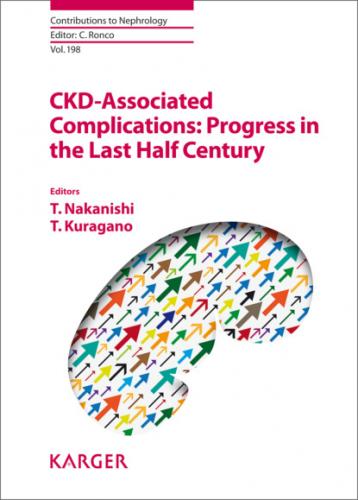Honda, H.; Hosaka, N. (Tokyo); Ganz, T. (Los Angeles, CA); Shibata, T. (Tokyo)
Sakashita, M.; Tanaka, T.; Nangaku, M. (Tokyo)
The Hepcidin-Anemia Axis: Pathogenesis of Anemia in Chronic Kidney Disease
Nakanishi, T. (Kobe/Nishinomiya); Kimura, T.; Kuragano, T. (Nishinomiya)
Anemia Management Considering the Pathophysiology of Elderly Chronic Kidney Disease Patients
Kuragano, T.; Mizusaki, K.; Kimura, T.; Nakanishi, T. (Nishinomiya)
This book presents a record of some of the outstanding presentations given at the 63rd Annual Meeting of the Japanese Society for Dialysis Therapy (JSDT), which was held from June 29 to July 1, 2018, in Kobe. At that meeting, the JSDT celebrated the 50-year anniversary of its founding as a voluntary academic association in 1968. With this experience of half a century as a backdrop, therapy for end-stage kidney disease (ESKD) now faces a number of vital issues besides the management of renal anemia and chronic kidney disease-mineral and bone disorder and the selection of the optimal treatment modality for each patient. These issues include the increasing incidence of malnutrition and frailty in the elderly, fragile vascular access, and the balance between medical costs and budgets. Here, expert members of the JSDT present 15 articles that address these issues. We truly appreciate the contributions of all the authors and hope that this book will promote further progress in understanding the pathogenesis of complications associated with ESKD and in providing optimal therapy for patients.
We dedicate this book to our patients, to whom we provide care as medical experts while we are actively engaged in the development of the JSDT.
Takeshi Nakanishi, Guest Editor
Takahiro Kuragano, Guest Co-Editor
Nakanishi T, Kuragano T (eds): CKD-Associated Complications: Progress in the Last Half Century.
Contrib Nephrol. Basel, Karger, 2019, vol 198, pp 1–11 (DOI: 10.1159/000496530)
______________________
Current Topics in Vascular Access: Superficialization of Arteriovenous Fistula
Masayoshi Nanamia · Kotaro Suemitsub · Yasuyuki Nagasawaa · Yukiko Hasuikea · Takahiro Kuraganoa · Takeshi Nakanishia, c
aDepartment of Internal Medicine, Division of Kidney and Dialysis, Hyogo College of Medicine, Nishinomiya, Japan; bDepartment of Internal Medicine, Division of Kidney and Dialysis, Kansai Rosai Hospital, Amagasaki, Japan; cDepartment of Nephrology, Gojinkai-Sumiyoshigawa Hospital, Kobe, Japan
______________________
Abstract
Background: An arteriovenous fistula (AVF) is considered the gold standard modality of vascular access (VA) for maintenance hemodialysis (HD) because of its superior patency, few complications, provision of high quality of life, and low risk of patient mortality. The rapid growth of the aging population and the high prevalence of comorbidities, particularly diabetes mellitus and peripheral vascular disease, in patients requiring HD inevitably deteriorate the ability to construct and maintain a conventional AVF because of these patients’ insufficient vascular adaptability. Furthermore, a substantial proportion of patients undergoing HD encounter non-maturation AVF failure and mis-cannulation-related complications, resulting in the need for a temporary VA procedure. Superficialization of the AVF is an alternative form of VA that facilitates the construction of an autologous fistula by maximizing the availability of a deeply located vein. Superficialization is also utilized in VA revision to improve the cannulability of an arterialized vein. Summary: Superficialization involves various approaches, including tunnel transposition, elevation, lipectomy, and liposuction. Tunnel transposition and elevation are prerequisites for construction of an alternative autologous AVF, especially a one- or two-stage transposed brachial-basilic AVF, which is widely recognized as preferential to an arteriovenous graft in patients who cannot undergo conventional AVF installation. Elevation, lipectomy, and liposuction are also employed as revisional interventions for approximating the depth of the arterialized vein and ensuring a sufficient cannulable segment in the forearm and upper arm area. More recently, modified minimally invasive techniques for each superficialization procedure have been introduced to avoid postoperative complications. Amid the growing methodological diversity of superficialization, increasingly more studies have been performed in an attempt to clarify its feasibility and outcomes. On the whole, most superficialization procedures have acceptable patency and safety profiles. However, the preferable superficialization approach varies in accordance with both the influence of the anatomic location and the inherent advantages and limitations of each procedure. Key Messages: Both careful assessment of a patient’s vascular adaptability and adequate comprehension of the various superficialization modalities that are available will enable optimal establishment of an autologous AVF in individual patients. This could lead to better outcomes and more successful management of HD.
© 2019 S. Karger AG, Basel
Introduction
Adequate vascular access (VA) is essential to ensure successful management of maintenance hemodialysis (HD) in patients with end-stage renal disease. The autologous arteriovenous fistula (AVF) has been the gold standard since the introduction of the radiocephalic wrist fistula by Cimino and Brescia in 1966 and is the basis of the current National Kidney Foundation Kidney Disease Outcomes and Quality Initiative (NKF-K/DOQI) guidelines [1]. According to the NKF-K/DOQI guidelines, an autogenous AVF should ideally be placed in a peripheral-to-central sequence, and radiocephalic and brachiocephalic fistulas are the preferred types of AVF.
The rapid growth of the aging population and the high prevalence of comorbidities, particularly diabetes mellitus and peripheral vascular disease, in patients requiring HD inevitably decrease the ability to construct and maintain a conventional AVF because of the lower vascular adaptability in these patients.
A prosthetic arteriovenous graft (AVG) is occasionally considered when suitable vascular anatomy is unavailable for fistula formation in areas such as the forearm and cubital fossa or when the superficial venous vasculature is inadequate for cannulable arterialization. However, evidence clearly shows that the AVF has superior patency, is associated with fewer complications, and requires fewer re-interventions than the AVG. The AVF also ultimately improves patient survival rates [1, 2]. Although proximal AVF construction is feasible, the inaccessibility of the arterialized vein because of its deep location in the upper arm is a matter of concern. Therefore, the availability of autologous vessels, including deeply located veins, should be carefully assessed when deciding the type of VA for AVF construction.
AVF superficialization has been suggested as an alternative form of VA to maximize the availability of autologous veins and, when used
